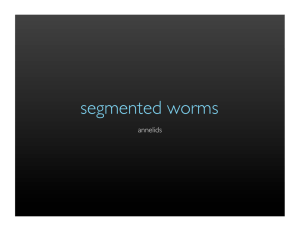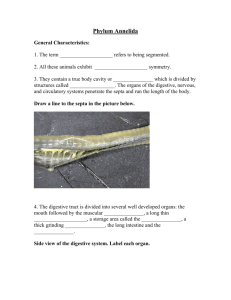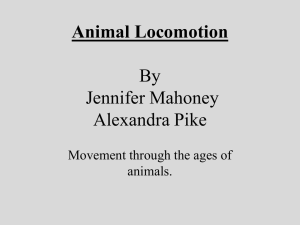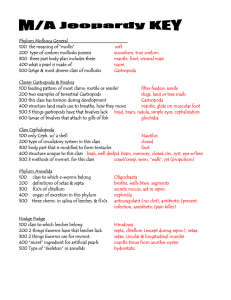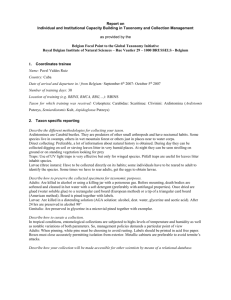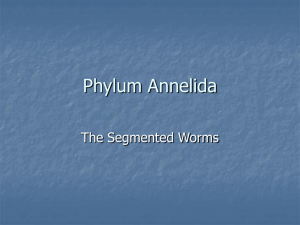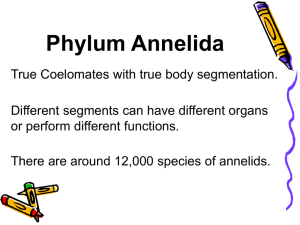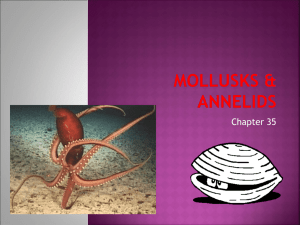Document 11623114
advertisement
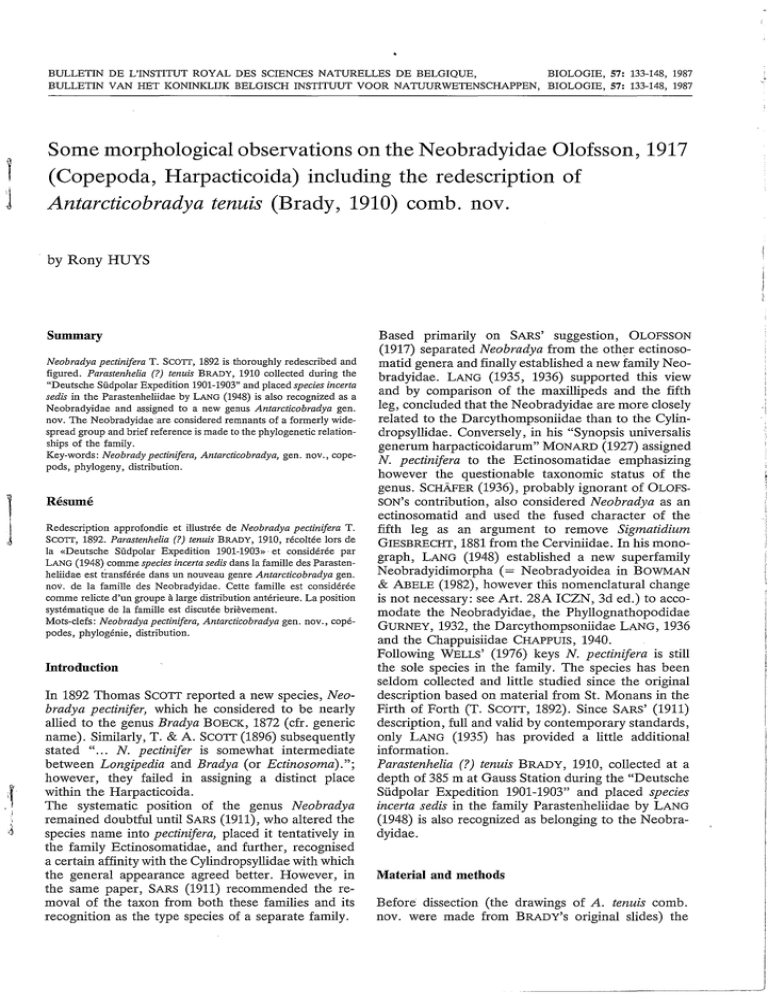
BULLETIN DE L'INSTITUT ROYAL DES SCIENCES NATURELLES DE BELGIQUE,
BIOLOGIE,
BULLETIN VAN HET KONINKLIJK BELGISCH INSTITUUT VOOR NATUURWETENSCHAPPEN, BIOLOGIE,
57: 133-148, 1987
57: 133-148, 1987
Some morphological observations on the Neobradyidae Olofsson, 1917
(Copepoda, Harpacticoida) including the redescription of
Antarcticobradya tenuis (Brady, 1910) comb. nov.
by Rony HUYS
Summary
Neobradya pectinifera T. SCOTI, 1892 is thoroughly redescribed and
figured. Parastenhelia (?) tenuis BRADY, 1910 collected during the
"Deutsche Siidpolar Expedition 1901-1903" and placed species incerta
sedis in the Parastenheliidae by LANG (1948) is also recognized as a
Neobradyidae and assigned to a new genus Antarcticobradya gen.
nov. The Neobradyidae are considered remnants of a formerly widespread group and brief reference is made to the phylogenetic relationships of the family.
Key-words: Neobrady pectinifera, Antarcticobradya, gen. nov., copepods, phylogeny, distribution.
1
J
Resume
Redescription approfondie et illustree de Neobradya pectinifera T.
1892. Parastenhelia (?) tenuis BRADY, 1910, recoltee !ors de
la «Deutsche Siidpolar Expedition 1901-1903» et consideree par
LANG (1948) comme species incerta sedis dans la famille des Parastenheliidae est transferee dans un nouveau genre Antarcticobradya gen.
nov. de la famille des Neobradyidae. Cette famille est consideree
comme relicte d'un groupe ii large distribution anterieure. La position
systematique de la famille est discutee brievement.
Mots-clefs: Neobradya pectinifera, Antarcticobradya gen. nov., copepodes, phylogenie, distribution.
SCOTI,
Introduction
In 1892 Thomas SCOTT reported a new species, Neobradya pectinifer, which he considered to be nearly
allied to the genus Bradya BOECK, 1872 (cfr. generic
name). Similarly, T. & A. SCOTT (1896) subsequently
stated "... N. pectinifer is somewhat intermediate
between Longipedia and Brady a (or Ectinosoma).";
however, they failed in assigning a distinct place
within the Harpacticoida.
The systematic position of the genus Neobradya
remained doubtful until SARS (1911), who altered the
species name into pectinifera, placed it tentatively in
the family Ectinosomatidae, and further, recognised
a certain affinity with the Cylindropsyllidae with which
the general appearance agreed better. However, in
the same paper, SARS (1911) recommended the removal of the taxon from both these families and its
recognition as the type species of a separate family.
Based primarily on SARS' suggestion, OLOFSSON
(1917) separated Neobradya from the other ectinosomatid genera and finally established a new family Neobradyidae. LANG (1935, 1936) supported this view
and by comparison of the maxillipeds and the fifth
leg, concluded that the Neobradyidae are more closely
related to the Darcythompsoniidae than to the Cylindropsyllidae. Conversely, in his "Synopsis universalis
generum harpacticoidarum" MONARD (1927) assigned
N. pectinifera to the Ectinosomatidae emphasizing
however the questionable taxonomic status of the
genus. SCHAFER (1936), probably ignorant of OLOFSSON's contribution, also considered Neobradya as an
ectinosomatid and used the fused character of the
fifth leg as an argument to remove Sigmatidium
GIESBRECHT, 1881 from the Cerviniidae. In his monograph, LANG (1948) established a new superfamily
Neobradyidimorpha (= Neobradyoidea in BOWMAN
& ABELE (1982), however tliis nomenclatural change
is not necessary: see Art. 28A ICZN, 3d ed.) to accomodate the Neobradyidae, the Phyllognathopodidae
GURNEY, 1932, the Darcythompsoniidae LANG, 1936
and the Chappuisiidae CHAPPUIS, 1940.
Following WELLS' (1976) keys N. pectinifera is still
the sole species in the family. The species has been
seldom collected and little studied since the original
description based on material from St. Monans in the
Firth of Forth (T. SCOTT, 1892). Since SARS' (1911)
description, full and valid by contemporary standards,
only LANG (1935) has provided a little additional
information.
Parastenhelia (?) tenuis BRADY, 1910, collected at a
depth of 385 m at Gauss Station during the "Deutsche
Siidpolar Expedition 1901-1903" and placed species
incerta sedis in the family Parasteriheliidae by LANG
(1948) is also recognized as belonging to the Neobradyidae.
Material and methods
Before dissection (the drawings of A. tenuis comb.
nov. were made from BRADY's original slides) the
134
Rony HUYS
habitus was drawn in lactophenol and body length
measurements were made. The specimens were dissected in lactic acid and the dissected parts were
placed in polyvinyl lactophenol mounting medium,
between two coverslips, and individually positioned
on Cobb aluminium slide frames. This mounting procedure allows the slide to be placed on either of its
surfaces so that both anterior and posterior aspects of
the appendages can be observed.
All figures have been prepared using a camera lucida.
Abbreviations used throughout the next and figures
are: Pl-P6 = first to sixth leg. The terminology and
presentation of the setal formulae are adopted from
LANG (1948, 196S). The terms pars incisiva, pars
molaris and lacinia mobilis are omitted in the description of the mandibular coxa (MIELKE, 1984).
BOXSHALL's (198S, pp. 341-344) terminology for the
maxillipeds and that of HUYS (in press, a) for the
caudal ramus structure are followed.
Systematics
Family Neobradyidae
Diagnosis:
Body slender, cylindrical, no distinct separation
between anterior and posterior body. Pl-bearing
somite fused with cephalothorax. Genital doublesomite without any trace of subdivision. Anal somite
small, markedly notched in middle of posterior border; anal operculum absent. Ventral abdominal muscles inserting at the anterior margin of the anal somite.
Caudal rami short, furnished with 6 setae; inner terminal seta (V) strongly developed, anterolateral
accessory seta absent (I).
Rostrum well developed, fused with cephalosoma.
Antennula with numerous plumose setae, first
segment shorter than second one; 9-segmented in
female, furnished with aesthetasc on fourth and ninth
segments; 10-segmented and subchirocer in male.
Antennal basis with setae; endopodite 2-segmented,
first one unarmed; exopodite 4-segmented, segments
1 and 4 with 2 setae. Mandibular praecoxa with two
setae at cutting edge; palp strongly developed with
unisegmented endopodite, 4-segmented exopodite
and 3 setae on the elongated coxa-basis. Maxillula
with trisetose coxal epipodite; exo-· and endopodite
defined at base and unisegmented. Maxilla with
4 endites on syncoxa; endopodite 3-segmented and
furnished with geniculate setae. Maxilliped not prehensile, phyllopodial; syncoxa with 1 strongly developed and 4 blunt setae; basis with 1 seta; unisegmented endopodite with 4 setae.
Swimming legs with small intercoxal plates. Leg 1
with both rami 3-segmented; proximal exopodite
segment without inner seta; distal exopodite segment
with S setae. P2-P4 with 3-segmented exopodites and
2-segmented endopodites. Baseoendopodite and exopodite PS at least partially confluent in both sexes;
baseoendopodite with 2 setae, exopodite with 4-S
setae and a remarkable tube pore. Sixth pair of legs
symmetrical and partially fused medially in the male.
Sexual dimorphism in antennula, endopodite P3
(occurrence of a remarkable tube pore on the anterior
surface), fifth and sixth legs and in genital segmentation.
One egg sac. Marine.
Type genus: Neobradya T. SCOTT, 1892.
Other genera: Antarcticobradya gen. nov.
Neobradya T. SCOTT, 1892
Diagnosis:
Neobradyidae. Second and third segments of antennula prolonged. First antennal endopodite segment
distinctly longer than second one. Proximal endopodite segment P2-P4 strongly prolonged, at least
3 times as long as average width. Distal endopodite
segment of P4 without inner seta. Baseoendopodite
and exopodite PS partially confluent in the female;
exopodite with S setae, the second innermost of which
is long and bare. Penultimate somite nearly 3 times
as long as anal somite.
Type and sole species: Neobradya pectinifera T.
SCOTT, 1892.
Neobradya pectinifera T. SCOTT, 1892
Material:
(1) Scotland, Firth of Clyde (collected by T. SCOTT):
1 female ( = "cotype") dissected on 8 slides and deposited in the British Museum (Natural History),
London, under no. 44496 as part of the Canon A. M.
NORMAN collection (no. 1911.11.8).
(2) Sweden, Skagerak, BoshusH:in, Bonden (collected
by H. KUNZ): 1 male dissected on 6 slides and deposited in the collection of the Recent Invertebrates
Section of the "Koninklijk Belgisch Instituut voor
Natuurwetenschappen", Brussels, under no. IG
27219.
Distribution (Fig. 7).
Norway: Korshavn, Lindesnes (SARS, 1911); Korsfjorden (DRZYCIMSKI, 1969). Sweden: Gullmar Fjord
(LANG, 1948); Bonden, Bohuslan (POR, 1964; KUNZ,
pers. comm.). Scotland: lnchkeith (T. SCOTT, 1903,
1906) and St. Monans (T. SCOTT, 1892, 1903, 1906)
in the Firth of Forth; Ballantrae Bank in the Firth of
Clyde (T. & A. SCOTT, 1896); Firth of Clyde (T.
SCOTT, 1903). England: Isle of Man (by l.C. THOMPSON: in T. SCOTT, 1906).
135
~(t(';
~~
A
~I
y/'.\.i\..
11<·\f
n~
.·,~:;·,:.://~·";-:./;:.:(
~
.
' ~~·>'"'':':>i:.<•:',:.
w:1~t':l~~.G~t
r
50 µm
B
20µm
c
136
Rony HUYS
REDESCRIPTION
Female.
Body length: 1230 µm rostrum and caudal rami excluded, 1310 µm rostrum and caudal rami included.
Body (Fig. lA) slender, cylindrical, yellowish and not
transparent. Nauplius eye not observed. Integument
pitted. Cephalothorax about 1/6 of total body length.
Pleurotergites of the thoracic somites well developed.
No distinct separation between prosome and urosome.
Genital double somite without any trace of subdivision. Penultimate somite prolonged, about 1.4 times
as long as average width. Anal somite shortest;
abruptly tapering distally in lateral view; markedly
notched in the middle of the posterior border. Somitic
hyaline frill plain. Caudal rami (Figs. 6D a, b) slightly
longer than wide and furnished with 6 setae: anterolateral accessory setae (I) absent, anterolateral one
(II) slender and bare, posterolateral seta (III) plumose
and standing dorsally near seta II, outer terminal seta
(IV) bilaterally plumose and confluent at base with
the strongly developed inner terminal seta (V), terminal accessory seta (VI) diminutive and spiniform, dorsal seta (VII) biarticulated at base and shifted towards
the outer distal corner. Anal operculum absent; pseudoperculum obsolete. Ventral abdominal muscles
(Fig. SD) inserting at the anterior margin of the anal
somite.
Rostrum (Fig. 2A) prominent, fused at base with
cephalosome, furnished with 2 sensillae, not extending
to distal border of first antennular segment.
Antennula (Fig. 2A) 9-segmented; first segment with
a spinular row and a plumose seta along the inner
edge; second segment longest, more than twice as
long as wide and furnished with 10 plumose setae and
a tube pore at the base; segment 3 provided with 7
closely set setae; inner subdistal corner forming a subcylindrical process from which a long aesthetasc, fused
at base with a slender seta, arises; segments 5 and 6
having 2 and 3 inner setae, respectively; segments 7
and 8 smallest and furnished each with a seta on both
inner and outer margins; distal segment furnished with
6 single setae and a trithek composed of a slender
seta, a minute setule and a short aesthetasc.
Antenna (Fig. 2B) strongly developed; coxa small;
basis squarish, furnished with some spinular rows and
a bipinnate seta at inner subdistal corner; endopodite
two-segmented, first segment longest and unarmed,
distal segment furnished with 7 setae (of which 6 geniculate) at anterior margin and 1 spine and 3 pinnate
setae at about middle of inner edge; exopodite 4-segmented, first segment longest and furnished with
2 setae and some long spinules, segments 2 and 3
square and bearing 1 seta, distal segment twice as long
as wide and furnished with 2 apical setae.
Mandible (Fig. 3A) with elongated coxa having a
spinular row in the middle and several strong nonarticulating teeth and 2 pinnate setae at the cutting
edge; basis fairly prolonged, furnished with ten
spinular rows and three setae along inner margin;
exopodite 4-segmented, segment 1 with 2 setae,
segments 3 and 4 with 1 seta each and segment 4 with
2 apical setae; endopodite unisegmented, bearing
2 setae at middle inner edge and 6 setae at distal end.
Maxillula (Fig. 2C). Praecoxa bearing two rows of
spinules; praecoxal arthrite furnished with 9 armed
spines and 3 plumose setae; coxa having 5 plumose
setae on the inner process and an epipodite represented by 3 setae; basis armed with some slender
spinules and forming two processes with 4 and 2 setae
respectively; endopodite unisegmented, broader than
long, bearing 5 plumose setae; exopodite well developed, unisegmented, defined at base, inner edge stepped, furnished with 4 setae.
Maxilla (Fig. 3B). Praecoxa and coxa forming syncoxa
having 4 endites, proximal endite armed with 5 setae
and closely set to the second one which is bilobed and
furnished with 3 setae, third and fourth endites closely
set to each other and furnished with 3 setae each,
surface of syncoxa armed with several spinular rows;
basis forming a cylindrical inner process bearing one
seta near the junction with the endopodite, one subapical seta and one spine and 2 setae at the distal end;
endopodite 3-segmented, segments 1 and 2 furnished
with 2 geniculate setae at the inner distal corner,
segment 3 having 4 geniculate setae and a small pit
in the outer rim.
Maxilliped (Fig. 3C) not prehensile, phyllopodial;
unarmed praecoxa and well developed coxa incompletely fused and forming a syncoxa which is armed
with a very long bipinriate seta at the surface and
4 blunt, strong, pinnate spines and 3 rows of different
spinules along the inner margin; basis armed with
slender hairs along the outer margin, some spinules
at the surface and a spinular row and blunt pinnate
spine along the inner margin; endopodite unisegmented, triangular, armed with 2 plumose setae and
2 stout pinnate spines.
Natatorial legs (Figs. 4A, B; SA, B) biramous, exopodites three-segmented, endopodites two- (P2-P4) or
three-segmented (Pl); intercoxal plates small, notched in the middle of the ventral side.
Pl (Fig. 4A). Praecoxa well developed; coxa furnished with some spinular rows on both anterior and
posterior sides; basis armed with long spinules and a
bipinnate spine at the inner subdistal corner and a few
minute spinules and a slender plumose seta at the
outer side near the coxal articulation; exopodite
segments 1 and 2 furnished with several spinular rows
and a subdistal bipinnate spine along the outer margin, distal segment armed with 3 bipinnate spines and
2 geniculate setae; proximal endopodite segment
without any seta or spine but armed with closely set
spinules along the inner and distal margins, segment
2 with a slender plumose seta at the middle inner
edge, segment 3 forming a pointed projection distally
and bearing 1 outer spine and 2 plumose setae, one
of which is geniculate.
A
20µm
8
Fig. 2. Neobradya pectinifera T. SCOTT, 1892: A. Rostrum and antennula of the female; B. Antenna; C. Maxillula.
138
Rony HUYS
Fig. 3. Neobradya pectinifera T. SCOTT, 1892: A. Mandible; B. Maxilla (arrow indicating a small pit in the outer rim of the
distal endopodite segment); C. Maxilliped.
Morpholo gy of Neobrady1"d ae
139
25 µm
AB
25 µm
D
20 µm
c
--··· j
140
Rony HUYS
P2-P4 (Figs. 4B; SA, B). Praecoxa represented as a
small rectangular plate at the outer subproximal
corner; coxa square, well developed; basis forming a
sharp process (in all probability with a secretary pore)
at the inner subdistal corner and armed with a pinnate
spine (P2) or a plumose seta (P3-P4) at the outer
edge; first endopodite segment strongly prolonged,
without any seta or spine; distal endopodite segment
forming a sharp projection distally; seta- and spine
formulae of the swimming legs are given in table 1.
Table 1
Spine- and seta formulae of the swimming legs in Neobradya pectinifera T. SCOTT, 1892.
Pl
P2
P3
P4
exopodite
endopodite
0.0.122
0.0.112
0.0.112
0.0.122
0.1.111
0.211
0.211
0.111
PS (Fig. 4D). Fifth pair of legs fused medially;
baseoendopodite and exopodite partially confluent;
inner process of baseoendopodite armed with 2 bipinnate setae, outer process with a smooth slender seta;
exopodite almost circular, furnished with a remarkable tube pore at the inner part of the surface and
armed with S setae, the innermost one longest and
bipinnate, the following one bare and slender, the
middle one diminutive.
Genital complex (Fig. 1 C) situated in anterior half of
genital double somite, furnished with a short, bipinnate spine and a long slender seta (which are non
articulating and confluent at base) at both sides; genital aperture clearly visible.
corners; distal segment forming a long spinous process
and armed with 7 setae and a short aesthetasc.
Leg 3 (Fig. 4C). Protopodite, exopodite and proximal
endopodite segment exactly as in the female; distal
endopodite segment with the same setal arrangement
as in the female, however, more slender and provided
with a remarkable tube pore at the anterior surface
and near the articulation with segment l.
PS (Fig. 6C). Fifth pair of legs fused medially;
baseoendopodite and exopodite partially confluent;
endopodital part of baseoendopodite partially free
and furnished with 2 bipinnate setae; exopodite almost
circular and provided with a tube pore at the surface
and armed with S setae: the outermost one bare and
slender, the middle one small and bi-articulated at
base, the others bipinnate and of different lengths.
P6 (Fig. SC). Sixth pair of legs symmetrical, partially
fused in the middle; each represented by an oval plate
and furnished at the outer corner with 3 setae: outer
seta longest and plumose, middle one smooth and
slender, inner one shortest and bi pinnate.
Spermatophore (Figs. 6A, B) elongate, relatively
small.
Antarcticobradya gen. nov.
Diagnosis:
Neobradyidae. Second and third segments of antennula almost as long as wide. Both antenna! endopodite
segments equal in length. Proximal endopodite
segment of P2-P4 squarish. Distal segment of endopodite P4 with inner seta. Baseoendopodite and exopodite PS completely confluent in the female; exopodite
with 4 setae, the second innermost of which is thick,
stout and bipinnate. Penultimate somite less than
2 times as long as anal somite. Type and sole species:
Antarcticobradya tenuis (BRADY, 1910) comb. nov.
Gender: feminine.
Antarcticobradya tenuis (BRADY, 1910) comb. nov.
Male.
Body length: lOSO µm rostrum and caudal rami excluded, 1110 µm rostrum and caudal rami included.
Habitus as in the female except for the free genital
somites (Figs. 6A, B). Sexual dimorphism in the
antennula, endopodite P3, fifth and sixth legs.
Antennula (Fig. lB) 10-segmented, subchirocer; first
segment furnished with an inner seta and some spinular rows; second segment longest and provided with
a tube pore and 11 plumose setae; third segment relatively short and having 9 setae; fourth one well-developed and bearing 10 setae, one of which is fused at
base with a long aethetasc; specialized joint between
segments 3 and 4 allowing considerable lateral flexion
of the distal portion; segment S having 2 setae; segments 6 and 7 forming subchirocer apparatus and furnished with a slender seta and several spinous structures each; segments 8 and 9 smallest and provided
each with a seta on both inner and outer subdistal
Synonymy:
Parastenhelia (?) tenuis BRADY, 1910.
Material:
Antarctica, Kaiser Wilhelm II Land, Posadowsky
Bay, Gauss Station: 1 female dissected on slide and
deposited in the Hancock Museum, Newcastle upon
Tyne, under no. 2.44.10.
Distribution (Fig. 8A).
Antarctica, Kaiser Wilhelm II Land, Posadowsky
Bay, Gauss Station (BRADY, 1910).
REDESCRIPTION
Female.
Body length: according to the original description by
BRADY (1910) about 770 µm; length of the urosoma
Morphology of Neobradyidae
141
.......
··....
\ /
c
8
25 µm
A-C
20 µm
D
Fig. 5. Neobradya pectinifera T. SCOTT, 1892: A. P3; B. P4; C. P6 of the male. D. Ventral abdominal muscles in the penultimate somite.
. _J
142
Rony HUYS
(excluding PS-bearing somite, including caudal rami)
is about 440 µm.
Body slender, cylindrical; no distinct separation
between prosome and urosome. Genital doublesomite without any trace of subdivision. Urosome
(Fig. 8E) tapering distally; somitic hyaline frill plain.
Penultimate somite relatively short, about 0.8 times
as long as average width. Anal somite shortest and
markedly notched in the middle of posterior border.
Caudal rami slightly divergent, slightly longer than
wide; furnished with 6 setae (arrangement and relative
size as in Neobradya). Anal operculum absent. Pseudoperculum weakly defined.
Except for the antennula and the antenna, the structure and ornamentation of the mouthparts is exactly
the same as in Neobradya pectinifera.
Antennula (Fig. 8B) 9-segmented; first segment furnished with a plumose seta at inner subdistal corner;
second segment longest, slightly longer than wide,
furnished with a distinct tube pore and a slender seta
along outer edge, two plumose setae at the surface
and 7 setae along inner margin; third segment nearly
square and bearing 7 setae in the anterior half;
segment 4 forming a sub-cylindrical inner process from
which a long aesthetasc and 2 slender, bare setae
arise; segments S and 6 furnished along inner edge
with 2 and 3 setae, respectively; segments 7 and 8
smallest and provided each with a seta on both inner
and outer subdistal corners; ninth segment twice as
long as wide and having 6 single setae and a trithek
composed of a slender aesthetasc, a bare seta and a
short setule.
Antenna. General structure as in N. pectinifera: 2segmented endopodite, 4-segmented exopodite (Fig.
8C); both endopodite segments equal in length, as
long as basis; first exopodite segment longest and
having 2 setae along the inner side and some fine
spinules at the middle outer margin, segments 2 and
3 squarish and provided with one seta each, distal
segment twice as long as wide and bearing 2 setae and
some minute spinules at the top.
Natatorial legs (Figs. 9A-E) biramous, exopodites
three-segmented, endopodites two- (P2-P4) or threesegmented (Pl); intercoxal plates small, not notched
in the middle of the ventral side but having two small
processi.
Pl (Fig. 9A). Praecoxa well developed, bare; coxa
armed with some spinular rows on both anterior and
posterior sides; basis having a stout bi pinnate spine
and some spinules at the inner subdistal corner, a
spinular row at the distal border and a slender plumose seta and a few long spinules at the outer side
near the articulation with the coxa; exopodite segments 1 and 2 spinulose along the outer margin and
furnished with a strong bipinnate spine subdistally,
distal exopodite segment having 3 bipinnate spines
and 2 geniculate setae; proximal endopodite segment
squarish and devoid of setae or spines, middle segment armed with an inner plumose seta, segment
3 forming a spinous distal projection and provided
with 1 outer spine and 2 slender setae, one of which
is geniculate.
P2-P4 (Figs. 9B-E). Praecoxa represented as a small
unarmed plate at the outer subproximal corner; coxa
rectangular, well-developed; basis forming a spinous
process at the inner subdistal corner and furnished
with a slender seta; proximal endopodite segment
squarish, without any seta or spine; second endopodite segment forming a sharp process distally; setaand spine formulae of the swimming legs are presented in Table 2.
Table 2
Spine- and seta formulae of the swimming legs in
Antarcticobradya tenuis (BRADY, 1910) comb. nov.
Pl
P2
P3
P4
exopodite
endopodite
0.0.122
0.0.112
0.0.112
0.0.122
0.1.111
0.211
0.211
0.211
PS (Fig. 8D). Fifth pair of legs fused medially; baseoendopodite and exopodite completely confluent; inner
process of baseoendopodite armed with 2 bipinnate
spines, the outer one of which is longest; outer process
with a smooth slender seta; exopodite furnished with
a tube pore at the surface, some spinules along the
inner side and 4 setae along the straight distal edge:
the inner one longest and bipinnate, the following one
stout and bipinnate, the other two slender and bare
and arising from a small protuberance (diminutive
seta absent).
Male.
Unknown.
Discussion
In their illustrations of N. pectinifera both T. Scorr
(1892) and SARS (1911) show the PS as having a total
of only four setae on the exopodite in both sexes, the
middle smaller seta apparently being absent. Even
LANG (1936) failed to observe its presence and,
moreover, both he and SARS (1911) drew the PS as
a completely fused plate. Neither author mentions
sexual dimorphism of the fifth leg although SARS
(1911) stated that " ... the last pair of legs (is) less
perfectly developed ... " in the male. Early descriptions also fail to demonstrate sexual dimorphism on
the swimming legs since the only reference I can find
is that of T. Scorr (1892) who mentioned that " ...
all the swimming feet ... (are) ... nearly alike in both
sexes". The slight modification of the endopodite P3,
i.e. the presence of a long tube pore in the male, is
Morphology of Neobradyidae
143
Fig. 6. Neobradya pectinifera T. SCOTT, 1892: (male) A. Urosoma in lateral view; B. Urosoma in ventral view; C. P5;
D. Caudal ramus (a: dorsal view; b: inner lateral view).
144
Rony HUYS
NORWAY
(
....
;
"i
_;
.i
I
i
i
~AN
Fig. 7. Neobradya pectinifera T.
SCOTT,
1892: Distributional records.
almost unique among harpacticoids being shared only
by some Marsteiniidae (HUYS, in press b). BODIN
(1968) showed a thin supplementary seta (Fig. 32, p.
56) in his figure of the male endopodite P3 of Tachidiopsis bozici. This structure is in fact a secretary tube
pore and indicates that in the Neobradyidae the middle and distal endopodite segments of P2-P4 are fused.
The large surface setae on the syncoxa of the maxilliped is easily detatched by dissection ant this is probably the reason why it is simply missing from T.
SCOTT'S (1892), SARS' (1911) and LANG'S (1936)
drawings.
LANG (1935) gives a drawing of the genital field,
which is mainly based on the internal cuticular structures and is incomplete with respect to the remnants
of the P6.
BRADY (1910) admitted that there were some doubts
as to the systematic position of Parastenhelia (?)
tenuis. LANG (1948) believed that P. tenuis could
belong to the Neobradyidae, but failed in ascertaining
its true identity due to the poor original description.
As first realised by LANG (1948, p. 592), BRADY
(1910) has transposed the first and second pairs of
legs (cfr. inner spine on basis) and presented an erro-
neous figure of the fifth leg. The partial redescription
given above, however, reveals that P. tenuis should
unquestionably be assigned to the Neobradyidae on
the basis of the mouthparts and the general morphology of the swimming legs and leg 5. It should tentatively be placed in a separate genus because of the
characters mentioned in the generic diagnosis.
The complete lack of any distinct separation between
the prosome and the urosome (either gymnoplean or
podoplean) in some primitive "oligoarthran" families
such as the Neobradyidae, forced POR (1984) to introduce a new term "dolichoplean". POR (1984) argued
strongly for the recognition of the Polyarthra in general and the Canuellidae in particular as the closest
presently known relatives of the primitive, benthic
"Archicopepoda", and discussed the possible relationships of some primitive "Oligoarthra". Though this
contribution seems - after a long period of dormancy
- to be an important starting point towards a concensus on harpacticoid phylogeny, some obvious misinterpretations have to be rectified.
POR's statement that the first pedigerous somite is
free in the Neobradyidae (Fig. 19, p. 19; p. 20) is
incorrect, and on the other hand, he has failed to note
that this is the case in the Aegisthidae GIESBRECHT,
E
...........
i:t.r:•:::":::::.'..·:\ ,::: ·.;.;· :.. · ·.·.·
.>x:~1
.... ·.:.
:·
. ........ ·.-:
:· . ...... :: ·.· .:· .. ·.. ·: . ... : .·.
I
E 100µm
~,·~t2:/:·:·.:'.:.::...·::.:::;:.:.:t·>,) \
. ..
........
. ·.···::
::·.·:::i:.::::·.·· . ·
' ··· ..··.. ·.· .. ·:·:_.,-._·...
:: ·. ·.··· ·.' . '
. : ............... ·
..
.. ..
'.
.. .'· ~-:.::::
I~'
B
Fig. 8. Antarcticobradya tenuis (BRADY, 1910) comb. nov.: (female) A. Distribution; B. Antennula; C. Exopodite of the
antenna; D. P5; E. Urosoma (excluding P5-bearing somite) in dorsal view.
___ j
146
Rony HUYS
Fig. 9. Antarcticobradya tenuis (BRADY, 1910) comb. nov.: (female) A. PI; B. P2; C. P3; D. Distal segment of endopodite
P4; E. Distal segment of exopodite P4.
Morphology of Neobradyidae
147
1892, in some Latiremidae BOZIC, 1969 and in Cubanocleta PETKOVSKI, 1977. According to PoR (1984,
p. 13) (probably) the most important character which
unites the Canuellidae and the Longipediidae is the
foliaceous maxilliped. However, this character is also
shared by the Neobradyidae and the Marsteiniidae
DRZYCIMSKI, 1969 (HUYS, in press b), and, consequently, his statement that " ... in all other Copepoda
the maxilliped is stenopodial", cannot be supported.
Finally, his identification of N. pectinifera is probably
incorrect since the specimen in his photograph (Fig.
1, p. 3) has long caudal rami and a habitus quite
different from the real N. pectinifera. It is even possible that this specimen belongs to another family
(Paranannopidae ?) since it shows a remarkable resemblance with Cylindronannopus.
being endemic for north-west Europe, Antarcticobradya being confined to the Antarctic Ocean.
As to phylogenetic relationships, RUYS (in press b)
rejected the concept of the Oligoarthra as a monophyletic group in general and that of the Neobradyidimorpha in particular and recognized the Neobradyidae as a taxon related to the Ectinosomatidae and the
Marsteiniidae ( = all species currently assigned to the
genus Tachidiopsis SARS, 1911 excluding T. cyclopoides SARS, 1911; see HUYS in press b) rather than
to the other so-called neobradyidimorphic (sensu
LANG, 1948) families.
The origin and evolution of the Neobradyidae can be
regarded as an early attempt at the exploitation of the
interstitial environment in coarse sediments. However, they have obviously been superseded by the
more succesfull (although primitive) Paramesochridae
and the advanced Cylindropsyllidae. They form
without doubt a phylogenetically ancient taxon and
their current zoogeographical pattern can be interpreted as being that of a relict group which was
formerly widespread. In this context it is surprising
that the Neobradyidae have retained their morphological integrity over such long distances, Neobradya
I am grateful to Dr. G.A. BOXSHALL, British Museum
(Natural History), London for arranging the loan of
Neobradya pectinifera. I would also like to thank Dr.
P .S. DAVIS, Hancock Museum, Newcastle upon Tyne,
for allowing me to examine the holotype of Antarcticobradya tenuis comb. nov. Grateful thanks are due
to Dr. H. KUNZ for providing material and to Mr.
D.C. GEDDES, Paisley College of Technology, Paisley
for reading and commenting on the manuscript. The
author acknowledges a grant from the Belgian Institute for the encouragement of Scientific Research in
Industry and Agriculture (IWONL).
Acknowledgements
References
BODIN, P., 1968. Copepodes harpacticoides des etages
bathyal et abyssal du Golfe de Gascogne. Memoires du
Museum National d' Histoire Naturelle, Nouvelle Serie, Serie
A, Zoologie, 55 (1): 1-107.
BOWMAN, T.E. & ABELE, L.G., 1982. Classification of the
recent Crustacea. In: ABELE, L.G. (Editor), The Biology
of the Crustacea. Vol. 1 Systematics, the Fossil Record and
Biogeography, pp. 1-29.
RUYS, R., (in press, b). The re-establishment of the family
Marsteiniidae Drzycimski, 1969. Hydrobiologia, in press.
LANG, K., 1935. Beitrage zur Kenntnis der Rarpacticiden.
2. Pseudobradya maxima n.sp. und des Mannchen von Pseudobradya hirsuta (T. & A. SCOTT) nebst Bemerkungen iiber
die Familie der Ectionosomiden. Zoologischer Anzeiger,
112: 332-336.
BOXSHALL, G.A., 1985. The comparative anatomy of two
copepods, a predatory calanoid and a particle-feeding mormonilloid. Philosophical Transactions of the Royal Society of
London, B311: 303-377.
LANG, K., 1936. Beitrage zur Kenntnis der Rarpacticiden.
5. Bemerkungen iiber die Sektion Agnatha MONARD, nebst
Aufstellung der neuen Familie D'Arcythompsoniidae. Zoologischer Anzeiger, 114: 65-68.
BRADY, G.S., 1910. Die marinen Copepoden der deutschen
Siidpolar-Expedition. Deutsche Sudpolar-Expedition 19011903, ll, Zoologie 3: 499-593.
LANG, K., 1948. Monographie der Rarpacticiden. Rakan
Ohlsson, Lund, 2 vol., 1682 pp.
DRZYCIMSKI, I., 1969. Rarpacticoida (Copepoda; wad
morkich okolich Bergen (zachodnie wybrzese norwegii) i ich
ekologia. Rozprawy Wyzsza Szkola Rolnicza w Szczecinie,
17: 1-72.
LANG, K., 1965. Copepoda Rarpacticoida from the Californian Coast. Kungliga Svenska Vetenskapsakademiens Handlingar, (4) 10 (2): 1-560.
RUYS, R., (in press, a). A redescription of the presumed
associated Caligopsyllus primus Kunz, 1975 (Rarpacticoida,
Paramesochridae) with emphasis on its phylogenetic affinity
with Apodopsyllus Kunz, 1962. Hydrobiologia, in press.
MIELKE, W., 1984. Some remarks on the mandible of the
Rarpacticoida (Copepoda). Crustaceana, 46: 257-260.
MONARD, A., 1927. Synopsis universalis Rarpacticoidarum.
Zoologische Jahrbucher, Systematik, 54: 139-176.
148
Rony HUYS
OLOFFSON, 0., 1917. Beitrag zur Kenntnis der Harpacticiden-Familien Ectinosomidae, Canthocamptidae (Gen.
Maraenobiotus) und Tachidiidae nebst Beschreibungen
einiger neuen und wenig bekannten arktischen Brackwasserund Siisswasser-Arten. Zoologiska Bidrag fran Uppsala, 6:
1-39.
POR, F.D., 1964. Les harpacticoides (Copepoda Crustacea)
des fonds meubles du Skagerak. Cahiers de Biologie marine,
5 (3): 233-270.
POR, F.D., 1984. Canuellidae LANG (Harpacticoida, Polyarthra) and the ancestor of the Copepoda. Crustaceana,
Suppl. 7: 1-24.
SARS, G.O., 1911. An Account of the Crustacea of Norway.
V. Copepoda, Harpacticoida. Bergen Museum, pp. 369-449.
SCHAFER, H.W., 1936. Harpacticoiden aus dem Brackwasser
der Insel Hiddensee. Zoologische Jahrbiicher, Abteilung fur
Systematik, Okologie und Geographie der Tiere, 68 (6): 445588.
SCOTT, T., 1892. Additions to the fauna of the Firth of
Forth. Part IV. Tenth Annual Report of the Fishery Board
for Scotland for the year 1891, Part III. Scientific Investigations: 244-272.
SCOTT, T., 1903. On some new and rare Crustacea collected
at various times in connection with the investigations of the
Fishery Boards for Scotland. Twenty-first Annual Report of
the Fishery Board for Scotland for the year 1902, Part III.
Scientific Investigations: 109-135.
SCOTT, T., 1906. A catalogue of land, fresh-water, and
marine Crustacea found in the bassin of the river Forth and
its estuary. Part II. Proceedings of the Royal Physical Society
of Edinburgh, 16: 267-386.
SCOTT, T. & A., 1896. On some new and rare Copepoda
from the Clyde. Annals of Scottish Natural History, 1896:
224-230.
WELLS, J.B.J., 1976. Keys to aid in the identification of
marine harpacticoid copepods. Department of Zoology,
University of Aberdeen, U.K., pp. 215.
WELLS, J.B.J., 1986. Biogeography of benthic harpacticoid
copepods of the marine littoral and continental shelf. Syllogeus, 58: 126-135.
Rony HUYS
Marine Biology Section
Zoology Institute
State University of Gent
K.L. Ledeganckstraat 35
B-9000 Gent (Belgium)
Note added in proof
Since this paper was submitted for publication,
SCHMINKE (pers. comm.) found several males and
females of A. tenuis in the Antarctic. In addition to
the peculiar tube pore on the endopodite P3, the male
of A tenuis exhibits slight sexual dimorphism in the
outer seta of the distal exopodite segment P3, a
character notably absent in N. pectinifera, and supporting the separate generic status of A. tenuis.
